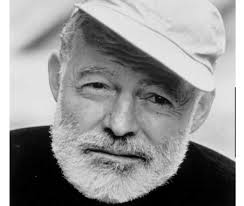 “The first draft of anything is shit.” – Ernest Hemingway
“The first draft of anything is shit.” – Ernest Hemingway
When I complete a first draft, I know I have created something out of nothing, no trivial achievement. I never throw first drafts away. I’m generally not too worried about quality. To make a rabbit stew, first catch the rabbit.
Hemingway’s pithy advice came to mind when I submitted a short story to my writing group recently. The feedback, both written and oral, was merciless, which is what we demand of each other. Still, the instinctive fantasy machine wants applause. The toilet-training child gets it when he “produces.” Why not me?
Some members of our group won’t submit something until it’s polished to a high sheen. The result is often dreadful anyway but often, sparkles can be seen within. That’s how writing goes. I wanted to submit my story to a contest whose deadline was only a month out, so I gave my group a first draft. I needed to know what I had, if anything, and I was willing to take the lashing.
Lashing I got. Although competently written, with a beginning, middle and end, and a main character with clear motivation, the story was bad. Everyone in my writing group knows how to write. The troubles went much deeper. Comments included:
“The first two pages are inert.”
“The opening line is flat.”
“Dialog is far too expositional.”
“Characters are not well-located in space.”
“The lawyer takes up too many words for what he does. Summarize him.”
“The husband needs to be either much more aggressive or entirely non-supportive. Otherwise, he’s just an echo chamber.”
“The story needs to rise to its theme, not be held down by it.”
“The big gap in this piece is that there is no second layer, no depth below what’s on the surface.”
“Your lists contain too many abstractions.”
“Hard choices are deferred. Get right to it.”
Ow, ow, ow! Our rule is that the person receiving the critique cannot say anything. No defensive explanations of what was intended. The piece speaks for itself. At the end, I’m allowed to ask questions. Then we all go out to dinner and laugh our heads off.
I put my meeting notes with the printed criticisms and stuffed the thick stack of paper onto a bookshelf and left it there for ten days while I worked on other projects. When I was feeling strong again, I retrieved the pile, went through every page, and considered every comment. I reflected on each one, evaluated it, sometimes reconceptualized it, noted when several people had said similar things, and discarded comments that seemed off base or idiosyncratic. I ended up with six pages of very pointed criticism.
I started a conceptual analysis of what I had intended the story to be, based on my original idea and the criticisms, which told me where execution had failed. I asked myself several questions and answered them.
- What was lost for MC?
- What does she want?
- Why can’t she attain her goals?
- How does she proceed?
- What are the outcomes?
I realized, with this exercise, that I had muddled my character’s motivation in the original story. She thinks she knows what she wants, but she is deeply conflicted and resents having to pursue her nominal goal at all. She solves the nominal problem in a way that’s not satisfactory, and that leaves her feeling worse than she did before. In the end, she doesn’t understand what happened, but hopefully, the reader does.
Next, I made a list of movements, or general beats, that I would need in a story to express in a clear way what I now saw as the main thread of the story. I did not go back to the original. I knew it from memory, and from what I intended, but I didn’t want to allow “what is” to subvert “what could be.”
I refined my list of high-level beats down into nine scenarios that might accomplish what I wanted. The story is only 2500 words, so I had to economize severely. I wasn’t satisfied with that list of scenes, but I couldn’t do anything more with it, so I left it. There are still almost three weeks before the deadline.
I went back to the original story and made a numbered list of its paragraphs with a very brief description of what each was supposed to accomplish. There were 72 paragraphs, combining some lines of dialog. That reduced the whole 10 page story down to 65 lines. I could immediately see that two secondary characters were superfluous.
That’s where things stand now. I’m not ready to rewrite. I need to revise my list of scenes and make sure they are going to tell the story I want to tell. I need to reconsider my narrative voice. It’s in third-person now. Should it be first? I need to juxtapose my characters to extract the inherent drama from each scene. I need to figure out how to say more by saying less, which is what’s going to happen when I re-do the dialog. In a couple of days, I’ll be ready to go.
Back to Hemingway. Are all first drafts shit? Yes, compared to what you intended. So do you polish that turd until it looks better? No. You reanalyze, reconceptualize, rethink, rewrite. The first draft holds the original idea or inspiration. Producing an artistic work requires more than inspiration. The process also requires materials, craftsmanship and persistent work. I’ve got everything lined up. Can I do it? I’m not completely sure that I can.
